
Blog
Balancing Disinfection and Safety: A Guide to Managing Chlorite and Chlorate in Drinking Water
Author: Colman Lynch
Managing chlorite and chlorate in drinking water is a critical aspect of ensuring public health and safety as drinking water quality is a powerful environmental determinant of health. Access to clean, safe drinking water is fundamental for human survival, with life depending on its availability. Ensuring a reliable supply of secure drinking water is crucial, as it not only safeguards public health but also drives socio-economic growth and improves overall well-being (HSE, 2024). Disinfection is the last treatment stage in a drinking water treatment plant, with this being carried out to ensure a residual concentration of disinfectant in the water distribution system to prevent growth of microbiological contaminants in the network (Sorlini et al., 2014). The disinfection of drinking water is a key public health measure, as unchecked microbiological contamination remains a significant and ongoing threat to human health. Various chemicals, such as chlorine, sodium hypochlorite, chloramines, chlorine dioxide, and ozone, are commonly used for this purpose. However, organic and inorganic materials present in untreated water can interact with these disinfectants, leading to the formation of different Disinfection By-Products (DBPs) including chlorate and chlorite (Righi et al., 2012).
This blog post explores the complexities of managing chlorite and chlorate in drinking water. It provides valuable insights into the risks, regulations, and practical solutions for ensuring safe and compliant water supply. By understanding the factors that contribute to the formation of these harmful byproducts and implementing effective management strategies, you can protect public health and safeguard your community’s well-being.
Regulatory Framework
The EU Drinking Water Directive (Directive (EU) 2020/2184) sets limits for managing chlorite and chlorate in drinking water. This legislation is implemented in Ireland under the EUROPEAN UNION (DRINKING WATER) REGULATIONS 2023. Chlorate was discovered in food in 2014 by a control laboratory. In 2015, the European Food Safety Authority (EFSA) found that levels of chlorate in drinking water and in foods were too high and could result in serious health effects (impaired functioning of the thyroid due to inhibition of iodine uptake), especially among infants and children. The maximum residue level (MRL) of chlorate allowed is 0.01mg/kg and is applicable to all food products under Regulation (EC) 396/2005. The EU Drinking Water Directive establishes a limit of 0.70 mg/l for chlorite and chlorate in drinking water, particularly in treatment processes that involve disinfection methods like sodium hypochlorite and chlorine dioxide, which generate these by-products on-site, however the guideline advises that member states should be striving for lower limits without compromising disinfection.
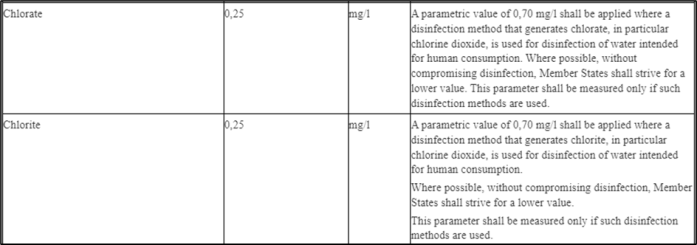
Figure 1: Limits set for chlorite and chlorate under EU Drinking Water Directive
The Role of Disinfection in Drinking Water Treatment
Effective managing chlorite and chlorate in drinking water is essential for public health. Disinfection is a crucial step in water treatment that helps prevent waterborne diseases and kills harmful germs in water supplies. In the 19th century, cholera caused serious outbreaks in many European cities. John Snow made important discoveries in 1854 while investigating cholera in London. He found that the disease spread from two water sources contaminated with sewage, and the outbreaks stopped once those sources were no longer used (Tulchinsky, 2018). Today, millions of people in low-income countries still suffer from waterborne illnesses, which can lead to death.

Figure 2: Broad Street Pump, John Snow Memorial, one source of infamous 1854 London cholera outbreak
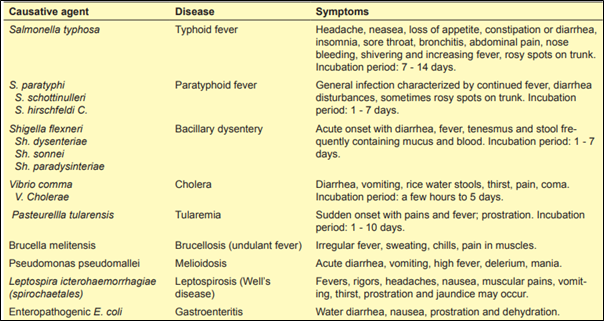
Figure 3: Waterborne diseases caused by bacteria

Figure 4: Waterborne diseases caused by Protozoa
One of the earliest known uses of chlorine to disinfect water dates back to 1897, when a bleach solution was used to clean a water main in Maidstone, Kent, UK, after a typhoid outbreak. Regular chlorination began in the early 20th century. The first continuous use of chlorine for water treatment is believed to have started in 1902 in Middelkerke, Belgium, where ferric chloride was combined with calcium hypochlorite to produce hypochlorous acid. In 1903, Ostende, Belgium, used chlorine made from potassium chlorate and oxalic acid. In the UK, sodium hypochlorite was first used routinely in Lincoln in 1905, also following a typhoid epidemic (IARC, 1991).
Chlorine can come in different forms, such as chlorine gas, sodium hypochlorite, or calcium hypochlorite. When dissolved in water, these forms produce hypochlorous acid (HOCl) and hypochlorite ions (OCl-). Hypochlorous acid is a weak acid that releases hydrogen ions (H+) and hypochlorite ions (OCl-) (Drinking Water Inspectorate, 2024). When hypochlorite is added to water, it reacts to form hypochlorite ions and hydroxide.

Figure 5: Reaction of a hypochlorite with water
Formation of Disinfection By-Products (DBPs)
Understanding the factors that contribute to the formation of chlorite and chlorate is crucial for managing chlorite and chlorate in drinking water. Hypochlorite solutions (HSs) are commonly used as disinfectants in drinking water production due to their strong oxidising properties and their ability to maintain a disinfectant residual throughout the water distribution system. Approximately one-third of drinking water treatment plants in the U.S. and nearly 80% in Canada use HSs in water production. Several factors contribute to the widespread use of HSs: they are easy to transport and store, require minimal handling expertise, and are generally considered safer compared to other disinfectant options. However, a key disadvantage of HSs is their instability, as they naturally degrade over time (Coulombe et al., 2019). The breakdown of hypochlorite ions leads to the production of unwanted inorganic by-products, such as chlorite, chlorate, bromate, and perchlorate. Although it’s impossible to completely prevent this decomposition, it can be significantly reduced by implementing proper procedures during the purchasing, handling, and storage of HSs (Coulombe et al., 2019).
The stability of hypochlorite solutions is significantly influenced by factors such as concentration, heat, light exposure, pH levels, and the presence of heavy metal cations. Over time, chlorine (I) undergoes slow disproportionation, eventually converting to chloride and chlorate. This process is accelerated at higher temperatures. Despite its higher oxidation state, chlorate is a poor oxidant-disinfectant and reacts much more slowly than hypochlorite, only under acidic conditions. The most stable solutions have low hypochlorite concentrations (under 10% available chlorine), a pH of 11, and are stored in darkness at temperatures below 20°C (Garcia-Villanova et al., 2010). It was observed that doubling the concentration of hypochlorite ions leads to a fourfold increase in the decomposition rate, indicating that the reaction follows second-order kinetics. Therefore, it is advised to dilute hypochlorite solutions by half, which lowers the concentration of hypochlorite ions and subsequently slows down the rate of decomposition (McCarthy et al., 2018). In one study, the sodium hypochlorite solutions had an average temperature of 13°C, with all samples below 18°C. While labels indicated active chlorine content between 12.4 and 15 g/100 ml, lab measurements showed a wide variation, with 25% of samples containing less than 4 g/100 ml, indicating a significant loss of active chlorine, which necessitates adding more disinfectant solution. Chlorite is formed by a slower reaction whereas chlorate is formed by the faster reaction, with chlorite generally only found when disinfecting water with chlorine dioxide, however chlorate is formed when disinfecting water with HSs (Garcia-Villanova et al., 2010).
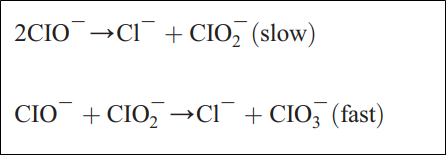
Figure 6: Formation of chlorite (slow) and chlorate (fast) (Garcia-Villanova et al., 2010)
The formation of chlorate ion in hypochlorite solutions is closely linked to storage methods and handling practices at utilities using bulk hypochlorite. Managing pH levels within the 12–13 range and maintaining careful temperature control can help limit chlorate formation during storage. Additionally, the quality of hypochlorite delivered to a facility can influence chlorate concentrations, due to conditions during storage after production and before delivery (Alfredo et al., 2015).
For systems that generate hypochlorite on site, chlorate production is highly variable, even from the same generator, with no notable differences among brands or types of solutions produced. Hypochlorite generated on site may contribute significantly to chlorate levels at some utilities. Research in the US shows that 33% of systems generating hypochlorite on site had chlorate levels exceeding 210 µg/L in their finished water with a 5-mg/L chlorine dosage. When the chlorine dosage increased to 10 mg/L, 66% of the systems tested exceeded the 210-µg/L concentration. However, only two of the 29 systems tested surpassed the WHO guideline of 700 µg/L (Alfredo et al., 2015).
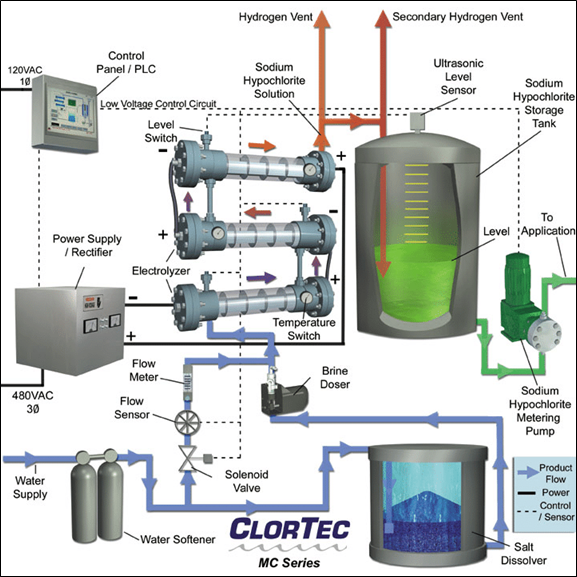
Figure 7: Example of On Site Electrochlorination system (OSEC) (Casson & Bess, 2006)
Health Implications of Managing Chlorite and Chlorate in Drinking Water
Managing chlorite and chlorate in drinking water is essential to protect public health. Chlorate has emerged as a residue of concern due to its thyroid disrupting properties, with it being classed as a goitrogen, or a substance which disrupts the production of thyroid hormones and interferes with the uptake of iodine (Twomey et al., 2023). A recent study conducted in Italy explored the link between chlorite and chlorate levels in drinking water and an increased risk of congenital anomalies, including cleft palate, urinary tract defects, spina bifida, and abdominal wall defects in women exposed to elevated concentrations. The study, conducted in Northern Italy, found that 3.4% of women in their first trimester were exposed to drinking water containing high levels of chlorite and chlorate (>700 µg/L). This exposure was associated with a significantly higher risk of developing the aforementioned birth defects during pregnancy (Righi et al., 2012). Chlorate is toxic mainly through ingestion and inhalation, often causing goitrogens and permanent damage to red blood cells. A fatal dose can be as low as 20 g of sodium chlorate or 230 mg/kg of body weight. Its use in U.S. weed killers has resulted in numerous cases of poisoning. When ingested, chlorate is absorbed in the gastrointestinal tract and excreted unchanged by the kidneys. High levels interfere with oxygen transport by permanently damaging red blood cells. A drop in haemoglobin is often seen in cases of poisoning (Alfredo et al., 2015).
Managing Chlorite and Chlorate Levels In Drinking Water
This section outlines strategies for managing chlorite and chlorate in drinking water. There is emerging research to support granular activated carbon (GAC) as a promising method of removing chlorate and chlorite from drinking water, however the removal of DBPs from drinking water is a challenging process (Sanchez-Cano et al., 2024). Priority should be placed on an approach to limit the formation potential for chlorate and chlorite. The following steps should be taken to mitigate the risk of DBP formation:
(a) Control hypochlorite storage conditions
Temperature control: Store sodium hypochlorite at a cool temperature (Below 25 °C ideally). Higher temperatures lead to a more rapid degradation of the hypochlorite into chlorate and chlorite. Higher temperatures speed up the chemical decomposition of hypochlorite and the subsequent formation of chlorate and perchlorate. Every 5ºC reduction in storage temperature can significantly slow down the production of harmful byproducts (Stanford et al., 2011).
Minimise storage time: Hypochlorite should be used as quickly as possible to reduce the time available for it to degrade. The longer hypochlorite is stored the greater the potential for the formation of chlorate and reduced disinfection effectiveness (Gordon et al., 1995).
Limit exposure to light: Light, especially UV light, can accelerate the degradation of hypochlorite, leading to increased chlorate formation. Hypochlorite should be stored in opaque containers. Tanks should be shielded from sunlight (Gordon et al., 1995).
(b) Control hypochlorite solution strength
Use lower concentration solutions: High-strength hypochlorite solutions (e.g., >10-12%) tend to degrade more rapidly into chlorate and chlorite. Consider using hypochlorite solutions at lower concentrations to reduce the formation of by-products. Higher initial concentrations of sodium hypochlorite will degrade at a more rapid rate to produce a lower concentration of hypochlorite over time than what would be observed by starting with a lower initial concentration. Additionally, in environments where sodium hypochlorite solution is present in high concentrations and is allowed to fully dry, particularly near heated areas like pump seals, there is a risk of sodium chlorate crystal formation. This compound is chemically unstable and poses a danger of exploding or igniting upon impact, potentially leading to severe injuries or damage to property (White, 2009).
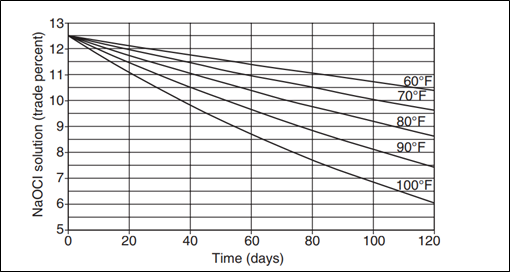
Figure 8: 12.5% Sodium Hypochlorite degradation (White, 2009)
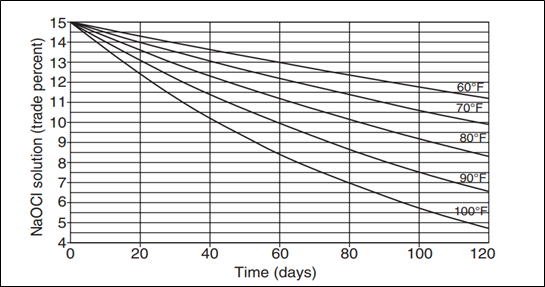
Figure 9: 15% Sodium hypochlorite degradation (White, 2009)
(c) Control pH
Maintain alkaline pH: Hypochlorite is more stable in alkaline conditions. Maintaining a pH above 11 in the storage tank reduces the rate of degradation into chlorate and chlorite. Below this pH the degradation will accelerate (Gordon et al., 1995).
(d) Minimise Metal Contamination
Use Non-metallic Materials: The high pH of hypochlorite will attack metals, while hydrogen gas will also be generated by contact with aluminium. Pipe leaks can emit chlorine gas and corrode nearby metal fittings. Use only plastic or fibreglass materials nearby. Metal contact causes catalytic decomposition of hypochlorite to oxygen gas and sodium chloride, so no metal parts should be in contact with hypochlorite, even high-grade metal.
Filter Out impurities: Control removal of transition metal ions by purchasing filtered hypochlorite solutions. For on-site generation by On Site Electrochlorination (OSEC) systems it is advised to use low metal ion concentration feedwater and salt, as transition metal ions in the water cause a greater rate of degradation of hypochlorite (Stanford et al., 2011).
(e) Regular Monitoring:
Monitor Chlorite and Chlorate Levels: Frequent monitoring of the solution for chlorate and chlorite levels can help ensure levels remain within acceptable limits. Adjust storage or operational parameters accordingly (Stanford et al., 2011). It is recommended that routine testing of sodium hypochlorite deliveries upon arrival is considered for pH, free chlorine, temperature and chlorate.
(f) Use Fresh Hypochlorite
Avoid extended storage: Hypochlorite gradually breaks down over time, generating by-products such as oxygen, chlorate, and perchlorate. Reducing the storage duration can limit the accumulation of these contaminants in the hypochlorite solution (Stanford et al., 2011). Storage tanks, including for OSEC systems, should be thoroughly cleaned at least once a year to prevent the accumulation of chlorate and chlorite residues. Enhanced monitoring is essential for high-risk locations, such as those with multiple chlorine dosing points, booster chlorination, intermittent use, or remote sites with extended supply chains. To reduce storage time, prioritize the use of the oldest hypochlorite solutions first.
Don’t Let Chlorite and Chlorate Compromise Your Water Quality
At Coftec, we understand the complexities and difficulties faced when dealing with disinfection byproducts such as chlorate and chlorite in drinking water. Contact us today to discuss how we can assist with your project, whether designing a new facility or refurbishing an existing one. Our multi-disciplinary team of scientists and engineers has a proven track record in developing innovative and practical solutions to problems such as high levels of chlorate or chlorite in drinking water and are here to help.
Email: info@coftec.ie
Phone: + 353 (0)91 844356
References:
Alfredo, K. et al. (2015) ‘Chlorate challenges for water systems’, Journal AWWA, 107(4). doi:10.5942/jawwa.2015.107.0036.
Casson, L. & Bess, J., 2006. On-site sodium hypochlorite generation. Proceedings of the Water Environment Federation, 2006, pp.6335-6352. DOI: 10.2175/193864706783761374.
Coulombe, L. et al. (2019) ‘Management of hypochlorite solutions used for water treatment in small drinking water systems’, Water Practice and Technology, 14(2), pp. 380–390. doi:10.2166/wpt.2019.025.
Drinking Water Inspectorate (2024) Chlorine disinfection. Available at: https://www.dwi.gov.uk/chlorine-disinfection/ (Accessed: 20 September 2024).
Garcia-Villanova, R.J. et al. (2010) ‘Occurrence of bromate, chlorite and chlorate in drinking waters disinfected with hypochlorite reagents. tracing their origins’, Science of The Total Environment, 408(12), pp. 2616–2620. doi:10.1016/j.scitotenv.2010.03.011.
Gordon, G., Adam, L. and Bubnis, B. (1995) ‘Minimizing chlorate ion formation’, Journal AWWA, 87(6), pp. 97–106. doi:10.1002/j.1551-8833.1995.tb06382.x.
HSE (2024) Drinking water and health. Available at: https://www.hse.ie/eng/health/hl/water/drinkingwater/ (Accessed: 20 September 2024).
IARC (1991) Chlorinated drinking-water, chlorination by-products, some other halogenated compounds, cobalt and cobalt compounds. Lyon: World Health Organization, International Agency for Research on Cancer.
McCarthy, W.P. et al. (2018) ‘Chlorate and other oxychlorine contaminants within the dairy supply chain’, Comprehensive Reviews in Food Science and Food Safety, 17(6), pp. 1561–1575. doi:10.1111/1541-4337.12393.
Righi, E. et al. (2012) ‘Trihalomethanes, chlorite, chlorate in drinking water and risk of congenital anomalies: A population-based case-control study in Northern Italy’, Environmental Research, 116, pp. 66–73. doi:10.1016/j.envres.2012.04.014.
Sanchez-Cano, G. et al. (2024) ‘Control of chlorite and chlorate in drinking water using surfactant-modified activated carbon’, Journal of Environmental Chemical Engineering, 12(2), p. 112131. doi:10.1016/j.jece.2024.112131.
Sorlini, S. et al. (2014) ‘Influence of drinking water treatments on chlorine dioxide consumption and chlorite/chlorate formation’, Water Research, 54, pp. 44–52. doi:10.1016/j.watres.2014.01.038.
Stanford, B.D. et al. (2011) ‘Perchlorate, Bromate, and chlorate in Hypochlorite Solutions: Guidelines for Utilities’, Journal AWWA, 103(6), pp. 71–83. doi:10.1002/j.1551-8833.2011.tb11474.x.
Tulchinsky, T.H. (2018) ‘John Snow, cholera, the Broad Street pump; Waterborne Diseases then and now’, Case Studies in Public Health, pp. 77–99. doi:10.1016/b978-0-12-804571-8.00017-2.
Twomey, L. et al. (2023) ‘Chlorate levels in dairy products produced and consumed in Ireland’, Foods, 12(13), p. 2566. doi:10.3390/foods12132566.
White, G.C. (2009) ‘Hypochlorination—sodium hypochlorite’, White’s Handbook of Chlorination and Alternative Disinfectants, pp. 452–527. doi:10.1002/9780470561331.ch9.
